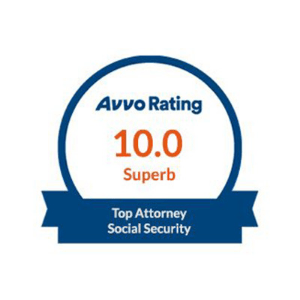Guide to Social Security Disability Applications
Call Us, Toll Free
Let us help you
Book a Free Consultation
Check my case
Free Case Evaluation Tool
Here is the list of resources and links we have shared during our webinar:
- Create your account on the SSA website: https://www.ssa.gov/myaccount/
- How much does a Social Security Disability attorney cost: https://www.laportelawfirm.com/our-fees/
- Download our ebook, A complete guide to the Disability application process: https://www.laportelawfirm.com/ebooks-disability-application-process/
- About LaPorte Law Firm: /about-us/
- Blog: What does a social security disability lawyer do
- Blog: A Step-by-Step Guide to Setting Up and Using Your my Social Security Account
- Blog: How to find the best social security disability lawyers near me
- Blog: How to hire free social security disability lawyers
- Blog: What is the maximum back pay for disability
- Blog: What conditions automatically qualify you for disability
- Blog: Working while receiving social security disability benefits
Webinar Transcript
Kevin LaPorte
Introduction
Hi, welcome. My name is Kevin LaPorte. I’m an attorney with the LaPorte Law Firm, and today we’re giving a presentation about a complete guide to the Social Security disability application process. A lot of our clients come to us initially with questions about what Social Security disability is, what the eligibility criteria are, how their conditions might qualify for Social Security Disability. And then, if approved, what does Social Security pay, and how can you find out that information? We’re going to cover some of these questions along with strategies for timing a disability application and some of the common reasons Social Security denies disability applications. I’m going to share my screen with you here, and we’ll get started.
Okay, so today’s presenters are—it’s myself, Kevin LaPorte, Kelsey LaPorte, an attorney with the LaPorte Law Firm, and Terry LaPorte, the founder of the LaPorte law firm. In terms of the plan, so today I’m going to cover what is Social Security Disability Insurance benefits. We found that a lot of our clients come to us without understanding the differences between Social Security disability or California State Disability, workers’ comp, other programs like that. All these programs have very similar names. It can be quite confusing, so hopefully we can help demystify what this system actually is.
I’ll also cover some very important information about how you can find out what your unique monthly disability amount is if you’re approved. I’ll go over some of the definitions of disability under Social Security rules, what rules might apply to your case if you apply.
And then Kelsey will get into information you need to gather before you file a disability application. Kelsey will also cover the 12-month rule, which is very important for timing a disability application. And then Terry LaPorte will go into some of the common reasons we see for people having their cases denied at the initial stage. And then he’ll cover some of the tricks of the trade and his general advice. And this is advice he’s gleaned over 40 years of representing disability clients through all stages of the process, from application stage to the federal district court stage.
So, in terms of what this is, Social Security, disability insurance is [an] earned benefit. You pay into it through your federal income taxes. And so for people who are below full retirement age, typically age 67, they can receive a disability benefit month by month up until then. So, it’s commonly referred to as permanent or long-term disability. It’s not quite permanent, but it can last for many months or even years, if you’re approved. Disability covers many millions of people in America. If you are not receiving disability, you likely know somebody who is or whose family member is—this is a massive federal program. In order to be eligible, you need to have worked for long enough and paid enough federal income taxes to have, they call it, “insured” your disability benefit. So, it’s like an insurance benefit in a sense, because you’ve paid into it, and if you’re eligible, under their rules, which we’ll cover, you can receive this benefit up until your full retirement age.
In order to be eligible, you have to prove that you are unable to work due to a disability, and this disability has lasted, or can be expected to last at least 12 consecutive months. That last part—this 12-month or duration rule—is very important, especially when it comes for strategizing about the timing of a disability application. And Kelsey LaPorte will cover that in more detail in the next section.
Our clients oftentimes wonder what their monthly disability benefit amount will be if they’re approved, or how much does Social Security disability pay. And the answer is, everybody who has worked for long enough, who’s paid enough Social Security taxes, has a unique monthly Social Security disability benefit amount. To find yours out, we recommend creating an account at the Social Security website. It’s called a my SSA—M-Y-S-S-A dot gov—account. And there, once you’ve created an account, you can log in and find out really important information, such as your unique monthly disability amount, what you would get if you’re approved for disability per month. You can find out your early retirement amount at age 62, your full retirement amount—in most cases, at age 67—and also if you qualify for other things such as auxiliary or family benefits.
So, the my SSA account, it’s very important to create this before going through a disability application. That way you can get all the numbers. You can find out what the amounts are, just so that there’s no surprises. And then also, importantly, you can check to see whether you’ve paid enough Social Security taxes to have funded or to be insured for the disability benefit.
Many clients ask us initially when they’re looking into doing an application is whether it’s a requirement to have an attorney. And the short answer is, no, you have a right to file for disability without hiring an attorney. There’s no requirement that you need an attorney. The longer answer, of course, is that we’re a bit biased, but we think it is in your interest at least to consult an attorney before going through a disability process. We provide free consultations at all stages, including if you’re still working and considering doing an application for disability—you anticipate going out of work, in other words. And the reason it’s important to at least consult an attorney is that they can assist you in coming up with something called your alleged onset date. That’s a very important date with disability cases, because that’s the date you’re telling Social Security your disability began, and that date needs to correspond with you stopping work and a medical event or a reason, medically, why you’re unable to work.
A disability attorney can also advise you about timing of a disability application. That’s how long to wait after you stop working to file an application. And then also, if you hire an attorney, there’s no out-of-pocket costs. So, our fees are contingency based, and contingency just means there’s no fee unless you’re approved and owed back pay. And so if that happens, you’re approved and you’re owed a lump sum back payment, the fee is just 25% of your back pay with a cap or a limit on fees of $9,200. This is regulated by Social Security. If you have an attorney, they deduct these fees automatically. So again, the fees are just 25% of your back pay with a cap or a limit of $9,200, whichever amount is less. And usually, because of the nature of disability cases, you’re usually owed a substantial amount of months of back pay. Social Security can pay up to 12 months prior to the month of your application, so long as you weren’t working during that time period. You can, all of us, consult our fee section of our website if you have questions about how that works, or give us a call.
Okay, so when our clients come to us asking the rules, what rules might apply to their case, the answer is always the same. So Social Security applies something called the five-step sequential evaluation to every claim for Social Security disability. And so I’m going to go over that with you here. So, the five-step sequential evaluation is Step 1, Social Security will look at whether you’re working. And in general, if you’re working, you’re not eligible for disability no matter how limited you are by your impairments. And in this system, this year, in 2025, they consider work any month where you’re grossing over $1,620 gross per month—net, if you’re self-employed—even if it’s part time. So, if Social Security sees work that’s at that level, they’re not even going to look at your medical records. They’ll issue something called a Step 1 denial.
If you’re not working, Social Security proceeds from Step 1 to Step 2, which is, do you have a severe impairment? That is, do you have a medical condition that has lasted or can be expected to last 12 consecutive months? This is typically a lower bar. Social Security typically agrees most conditions, such as back pain or depression, things that have lasted for a while, those will be severe impairments. So usually, the hurdle is overcome at this step, and Social Security will go on to Step 3, which is deciding whether your condition meets one of their medical listings. And so a listing—that is just the Social Security sort of Blue Book dictionary definition of a disability under their rules. These are strict medical criteria, typically, and they require certain pieces of medical evidence that met the—that rise to these levels. If Social Security says, “We don’t think your condition meets one of our listings,” the inquiry is not done there. That’s not an automatic denial.
Social Security will then proceed to Step 4, and that is, can you do any of your past relevant work? And so in Social Security cases, past relevant work, that’s any work you’ve done in the last five years. If Social Security thinks, yep, you can go back to the job you were just doing before you became disabled, they have to issue a Step 4 denial. If not, if they agree, your medical conditions would prevent you from doing that work, they go on to Step 5 [which] is, could you do some other type of job in the national economy? [In] Step 5, the burden of proof is on Social Security to point to a job they think you can do. [In] Step 4, the burden of proof is on you. You’ve got to prove you can’t do any of your past relevant work. Step 5 gets a little more complicated, depending on your age. If you’re under age 50, general burden is you’ve got to show you can’t do the easiest job in the national economy. Job is eight hours a day, five days a week, full-time work. If you’re over age 50, they’ve got to consider, typically, your skills and whether you have transferable skills to other sort of similar types of jobs in the national economy. Each case is different, of course, and there are different rules that apply to each of these sections, but in general, the five-step sequential evaluation applies to every claim for Social Security disability benefits.
And I’m going to turn it over now to Kelsey LaPorte to cover what information you need to gather before filing an application for disability. Thanks a lot for sticking with us and Kelsey, why don’t you take it away? Thank you.
Kelsey LaPorte
Thanks, Kevin. Let’s next discuss what information you need to gather and have ready before you file your disability application. The disability application process requires a lot of detailed information, and the more prepared you are, the faster and smoother it will go. This information is crucial for verifying your identity, determining your eligibility, and processing your benefits accurately.
So before you start the process of applying for Social Security disability, you must gather your personal information. This includes everything from your Social Security number to your date of birth, and even the city where you are born. If you are not born in the United States. You must also gather your naturalization certificate, if you’re a naturalized citizen, or your permanent resident card, if you are a legal resident. If you are currently married or divorced and had a marriage that lasted longer than 10 years, or have a minor age child, you will also need to be ready to provide the names of your spouse and/or children as well as the details of your marriage. SSA needs this information to determine if there are any auxiliary family benefits available to your spouse or children.
You’ll also need to provide information about your work history. One of the most important steps in your application is providing accurate and complete work history information. You need to list all of the income you’ve earned in the last two years, as well as the work history you performed in the last five years. The SSA will want a list of all the job titles and duties. Terry will touch on this more in a moment, but it is important that you provide an accurate account of your job duties and responsibilities before you became disabled. SSA will need this information to better understand what you did before you became disabled.
When applying for disability, one of the most critical pieces of your application is the medical information you provide. The SSA needs this information to understand the nature of your disability, how it impacts your ability to work, and whether you meet the SSA’s criteria for disability benefits.
First, you’ll need to provide a list of impairments. This list of impairments is everything you have been diagnosed with that affects your ability to work for at least 12 months. You do not need to list everything you’ve been diagnosed with, but you should come up with a list of everything that you’ve been diagnosed with that affects your ability to work.
Second, you’ll need to list your doctors. This treatment provider list may also include the names of your physical therapist, occupational therapist, or otherwise. The SSA will need this list with contact information. You don’t need to submit your medical records to the SSA, but after you file your application, the SSA will gather your medical records to review them and determine your disability. Therefore, in the application, you’ll need to provide the SSA with a list of your doctors, their contact information, and the dates of your treatment with them.
During the application process, the SSA will continue to gather and review your medical treatment records. And here’s an important part: if you’re still receiving treatment or seeing doctors, keep them updated on your situation. A continuing relationship with your healthcare provider strengthens your case and shows that you are actively seeking the care that you need.
As you prepare to file your disability application, there are a few important forms you’ll need to sign along the way. The SSA needs your written permission to collect information about your medical and work history. Without your signature, they can’t access critical records or get the necessary information to process your claim. These forms include the SSA 827, which is the medical authorization form, and the SSA 8240, which is the wage and employment authorization form.
In addition, after you file your application online, the SSA will mail you a summary copy of your application. You have to sign a copy of the application and submit it to the SSA. This signature tells SSA that the details that you provided in the application are true and accurate to the best of your knowledge, and the SSA won’t process your application until they received the signed form.
While the application is pending, the analyst is who is assigned to your claim may send you additional questionnaires to complete. These questionnaires are your opportunity to explain to the SSA how your disability affects you on a day-to-day basis, the most commonly requested form we’ve seen is the function report. In the function report, you’ll answer questions about your activities of daily living. You should be ready to explain to the SSA your limitations. Provide examples: What sort of assistance do you need to complete activities of daily living? What are some activities you have to do at a slower pace or not be able to do at all? By clearly describing any difficulty you might have had with things like lifting, walking, concentrating, or completing tasks, the function report helps build the case that your disability prevents you from maintaining gainful employment.
It’s important to time your application correctly. Here’s what you need to know about when to file the application.
As you navigate the Social Security disability application process, there’s a term that often comes up, and it’s important to understand. That’s the 12-month rule. You might have heard your disability needs to last a certain amount of time in order to qualify for benefits. But what exactly does this mean, and why does that matter? To qualify for benefits, your condition must be a disabling impairment that has lasted or is expected to last 12 consecutive months. Because you must demonstrate that your disability will last 12 continuous months, as a general piece of advice, we typically recommend that you wait four to six months before filing your application. I know that might sound like a long time to wait, especially when you’re eager to get the support you need. But waiting just a few extra months can make a huge difference in the success of your application, and let me explain why.
If you stop work and file your application right away, before your disability has been well established, there’s a risk that the SSA could deny your application. They might not be convinced that your disability will last 12 months, especially if you don’t have enough medical documentation or evidence to back up your claim. One of the most common reasons for denials is that the SSA doesn’t have enough evidence to prove that you are not able to perform gainful employment, or that your disability will not last at least 12 months. By waiting just a little longer, you can reduce the chances of this happening. Waiting a few months also gives you the opportunity to seek the medical treatment you need. Medical records are a critical part of your application. The SSA will review your treatment history to see how your condition has progressed and whether you’ve been following your doctor’s advice. By the time you file, you’ll have a stronger, more detailed medical history, which makes it easier for the SSA to understand the severity of your disability and how it impacts your life. The more solid your medical documentation, the stronger your claim will be, and the less likely it will be denied.
After you submit your application, the very first place it goes is to your local SSA field office. This office is responsible for reviewing the initial information you’ve provided to process all of the forms and information you submitted. The field office is also responsible for assessing the nonmedical eligibility requirements. For SSDI claims, you must have earned enough work credits to be insured under Social Security, meaning you worked long enough and paid into the Social Security system. Generally, that means that you’ve worked 5 of the last 10 years before your disability began. For SSI claims, you must meet strict income and asset limits. This means that your total resources, such as savings, property, or investments, cannot exceed a certain threshold. Additionally, your monthly income must be below a specific amount. Generally, this is $2,000 for an individual and $3,000 for a couple in assets and income.
So once the Social Security field office has processed your application, the next step is to send it over to the Disability Determination Service, or DDS. The DDS is made up of medical and vocational experts who carefully review your case. They are the ones that will actually decide if you meet the SSA’s definition of disability. Once the DDS makes a medical determination, the case is sent back to the SSA for final processing of its decision. If you’re approved, you will receive a notice of award in the mail. And if you’re denied, you will receive a notice of disapproved claims.
Navigating the Social Security disability process can be challenging, and one of the most frustrating experiences is receiving a denial. Here are several common reasons why claims get denied, and understanding them can help you prepare better for your application or any possible appeal.
One of the most frequent reasons for denials is insufficient medical evidence. Social Security requires clear documentation of your disability showing that it significantly limits your ability to work. The medical evidence must demonstrate that you can’t do your past work and other work in the national economy. Without thorough medical records or specific details about how your condition impacts your daily life, your claim might not meet the necessary criteria.
To qualify for benefits—for SSDI benefits—you must show that your disability began before your date last insured. This is the last date you were eligible for Social Security coverage based on the time in which you’ve paid into Social Security. This date is crucial because to be eligible for benefits, you have to show that your disability occurred while you were still insured under the Social Security system. If you’re unable to demonstrate that your disability started before this date, your claim may be denied.
Your claim can also be denied if drug or alcohol abuse is found to be a primary factor contributing to your disability. The SSA does not provide benefits for disabilities that are caused by or primarily related to substance abuse. In our experience, the SSA will typically make this assessment if you have a non-exertional impairment and are alleging a mental health impairment that affects your ability to work.
In mental health cases, the SSA must decide whether the mental health condition would still be disabling without the substance abuse. If the mental illness would still prevent the person from working, even if they stopped using drugs or alcohol, then the substance use is not material, and they still might qualify for benefits. But if stopping the substance use would mean the person is no longer disabled, then the substance use and abuse is considered material, and they won’t be approved for benefits.
If your claim is denied, remember that it’s not the end of the case. Many people successfully appeal their denial with additional evidence or clarification.
So at this time, I’m going to hand it off to Terry to give additional tips during this application process.
Terry LaPorte
Thank you, Kelsey. If you’re considering whether to file an application for Social Security disability, to be successful, Social Security must decide that you’re unable to perform full-time work for a minimum of 12 consecutive months. Now, if you know that to be true, you need to think about how your application will be decided. That is, whether you’re going to be one of the 35% of applicants who are approved, or one of the 65% who are denied and then have to endure a long appeal period.
The most important information that the Social Security evaluators will be looking at is your medical treatment record and decide—deciding whether there’s a sufficient reason that you had to stop work because of your health. In many cases, it’s obvious: you’ve had a serious accident or a heart attack or stroke or some other—some other event where it was clear this is why you had this particular beginning date of disability. In those cases, the evaluators’ really most important duty is to decide whether the effects of your health problems following that event will be disabling a year later, at least 12 consecutive months after you stopped work.
But we see many cases where the beginning date of disability is less clear, where you have had a chronic diagnosis for years and been struggling to keep your job as long as possible, working to pay the rent or mortgage, pay the bills for you and your family. Years where you’re experiencing worsening pain, worsening stamina problems, while you struggle to keep your job. Sometimes, you reach the point where you just can’t do it any longer. And in my experience, Social Security does not appreciate you, the heroic worker who just finally reaches the point that you can’t keep working in your full-time job anymore. Now that may be because Social Security sees that—Social Security records show that you have had full-time income from a job for many years, even though you had your cancer diagnosis several years ago, or you had a back surgery or two several years ago. And so it’s harder for them to see why you stopped work at that particular time.
They also, perhaps skeptically, are looking to see whether or not people applying for disability are really now disabled or just wanting to retire early with disability money paying the way, or an employment-based release reason for stopping work or losing your job because of a layoff, or AI-related reasons or some other employee policy that caused the end of of your work.
So, our recommendation is that you talk to your treating doctors in the weeks and months, as you consider, towards the end, if you may have to stop working, and to let your doctors know, as you are seeing them, the specific job duties you’re having a difficult time doing from that chronic problem, whether it’s heavy lifting, prolonged standing, prolonged, sitting, keyboarding or mousing doing computer work over an eight-hour day. If the doctor’s documenting in your medical records not just your health problems, not just your diagnosis, but also noting the problems that you’re having in carrying out your job, the Social Security evaluator will see the basis for your claim, where you allege a specific date when you had to stop work.
We’ve also found that it’s a good idea that once you decide to apply for disability that you discuss the potential disability application with your doctor. You kind of want to glean a response as to whether your doctor appreciates or understands the severity of your health problem as it relates to your ability to work full time. And let the doctor think about that. If you’ve been dealing with a chronic medical problem for many years, again, this chronic rheumatoid arthritis or lupus or bad back or neck, get those problems checked out again. By that, we mean Social Security is very test oriented. They’re very number oriented. So if your doctor says, “Let’s have you get another MRI or a blood test to check inflammatory response,” that’s a good time to do it in the weeks before, in the weeks after that you stop work.
So, for example, on an MRI, if there’s changes in your back MRI worsening objectively compared to MRIs you’ve had a few years ago, then Social Security can more easily see the reason why you feel this worsening pain, it’s causing you to be unable to carry out all the duties of your job.
Now, it probably seems obvious that you should be a compliant patient and do the treatment that your doctor prescribes. What we’ve seen in our firm over the years [is] that we’ll have clients who are resistant to their doctor’s recommendation for new or updated treatment. They’ll say, “I’ve done that physical therapy years ago, or had that injection. Those things didn’t help much, and I’m not willing to go through a certain referral to see a specialist for my condition. I know that I just can’t deal with it anymore.” Well, now you’re dealing with an audience, though, with Social Security. And they’re looking for someone who—to see whether they’re complying with their doctor’s recommendations for treatment.
Part of that question, that kind of evaluation, is a belief that if you’re really having disabling pain and limitations, so that you not only have to stop work, but you can’t do the—your loved hobbies or carry out your activities of daily living in the same way that you would be expected to pursue everything, every attempt to try to fix the problems that you have. And if you do that, a picture is created in your medical record showing new treatment, new tests, new evaluations by specialists. So, the reasonable Social Security evaluator will be more likely to want to approve your application.
Now, one of the more important pieces of evidence that can help the chance of success in a disability application is whether your primary physician or your specialist physicians can complete what we call an RFC questionnaire. That’s a Residual Functional Capacity questionnaire stating your doctor’s opinion on what restrictions you have with specific job tasks required in your full-time work. Again, prolonged sitting or standing, number of pounds— specifically—the number of pounds that you can lift or carry, both occasionally and frequently, how many hours of the day your doctor feels that you can keyboard or mouse or reach forward with your arm, given the limitations of your neck or carpal tunnel, or other health problems.
Understand that Social Security is going to approve or deny your claim based upon the opinion of a doctor, just on those points—those specific functional points. And these are doctors that don’t even see you. They don’t treat you, but they do chart reviews, and the important part of the chart will include the medical treatment and the records. But oftentimes the doctor in those cases is not writing down what they think your limitations are. So, if you can get an RFC form completed by your doctor, that will help the chances of success in your case. Social Security won’t do that: they will not contact your doctors to get specific RFC forms, even though they have them, and in years past, they were more likely to request that the treating physicians provide that information. So, you may have to do it yourself. You provide the form to your doctor, [it] comes back from the doctor, and then you’re going to have to file it with the Social Security Administration for review. So again, the Social Security evaluator will know what your doctor’s opinion is concerning your work limitations, and that can help the chance of success of your application.
What we normally see, though, is not an RFC questionnaire, but sometimes, we’ll see narrative brief reports where the doctor says, “My patient, Sally Smith, is totally disabled because of their XYZ diagnosis.” Those reports, those brief narrative reports, are ignored typically by Social Security. Social Security doesn’t know whether the doctor is really using the term totally disabled in the same way that they do at Social Security, or whether the doctor thinks it’s a state disability or workers’ compensation, or even VA disability rating. The issue of these RFC questionnaires and the specific functional impairment and doing a job full time is pretty much the whole ball game with most Social Security claims. So, Social Security is more likely to approve your application when they can see what your doctor’s opinion is.
Now, as we’ve noted, disability with Social Security does not call for a medical evaluation—just for a medical evaluation, but most commonly as an occupation or vocational issue. Social Security, in most cases, can approve a case where you meet the burden of showing that you can no longer perform past relevant work, which these days, means work that—any kind of job that you’ve done for long enough to be able to know how to do that job in the last five years. First, they look at the way you did your job, then they look at how that job is normally classified in the national economy by the US Department of Labor.
As a law firm often representing clients on appeals, we sometimes see that you might have been labeled a senior worker or a manager or assistant manager, say, in a retail store where your duties really were to be a cashier to stock items like everyone else does, and you were given the assistant manager title because you’ve been around forever, and maybe you locked the door on the way out that — after the day is over. But you weren’t really doing any managerial duties, such as hiring and firing or training other employees or performing employee evaluations. So, the problem gets to be that while Social Security understands what you say you did in your job, they feel like your job should be classified as a manager—say, as a lead worker, a foreman, which may, under federal standards, be a lighter kind of job than what you actually did throughout the work day. So, this kind of mislabeling when you really didn’t perform manager or supervisory duties can get your application denied inappropriately.
Another error where we sometimes see is that when you complete the work history form, you describe your duties as you did them in the last weeks or months after you first experienced your injury or illness, rather than how you did the job normally in the many years that you worked in that job. This may mean that you’re telling Social Security inaccurately that you did the job really at a light level when it only became light after the heart attack or after the injury, where the employer said, “Okay, we’re going to let someone else here in the crew do the heavy lifting, so you don’t have to do that anymore,” with the hope that you’re going to get back to full duties. The work history form should be completed on how you did the work during the majority of your career, and not just for a short time when you were being accommodated because of your worsening health.
It should go without saying that Social Security employees should be treated with respect. And I think it’s particularly important these days to recognize, you know, they’ve always had a very difficult job. Their job has only gotten to be more difficult with declining staff levels and more work demands. We believe strongly that anger or impatience is not in your interest as far as getting a proper processing of your applications. Social Security employees are human. They’re providing a public service, and we should be ready to thank them for the positive things that they do for millions of Americans with their retirement and disability claims.
Now, in about 60% of cases, Social Security will send you to one or even two medical examinations. They’re called consultative examinations. These examining doctors don’t make the decision in your case, but they provide data. They issue a written report and say, after a physical exam, they’re going to report on their observation of your walking or whether you needed a cane or other kind of device. They’re going to measure strength, a range of motion of multiple joints, and report that as data in the form. In some of the cases, Social Security will send you out to a psychiat— psychologist or a psychiatrist to do a mental health exam, evaluating both mood and perhaps any cognitive issues you may have from your psychiatric problems. In all those cases, the consulting doctor is providing a report that will report facts of the exam, but also offer opinions on your ability to function in these job categories.
In mental health exams, they may be looking at whether you can perform stressful or sometimes detailed or complex work—whether you can work with the public, whether you have any problems getting along with supervisors or coworkers. These are opinions that are provided, and their reports are given some significant weight on the decision-maker, who, again, is a physician who has never seen you and reads the Social Security examining doctor’s report, but also all of the medical records, all of the medical opinions and assessments from your doctors. When you go to these CE (consultative exam) exams, be on time, put forth good effort, try to establish rapport with the doctor while being examined, be prepared beforehand to explain the two or three things that are most limiting to you as far as your physical effort or your mental concentration over the equivalent of a full-time work schedule. Your comments to the consultative doctor are likely to be included in the report, and it may make a difference in the approval of your case.
Also, we have found in some of the Social Security consultative exam reports that they’re not accurate and state that a full examination took place when it did not. You should glance at your watch without making it obvious to later record the actual number of minutes that you were with the Social Security doctor. If you feel that the doctor didn’t examine all of the areas of your body that cause you pain limitations, then note that. Go home. Write it down.
I just recently had a case where my client had chronic back problems. That was the number one problem after two prior back surgeries. But as the years went on, he developed a right knee condition, and by the time he saw the Social Security doctor, he had gotten such bad arthritis in the knee that he had a right knee replacement surgery scheduled in the coming months. The Social Security examining doctor didn’t even mention the right knee. And so again, when you can experience that the knee wasn’t even looked at or examined, as happened in this case, that’s going to give less weight to the opinion of the Social Security doctor who didn’t really do a full exam.
We’ve had some couple of other cases over the years. Say, for example, there was a specific Social Security consultative exam during the pandemic who was very concerned, of course, about the COVID virus. She wore a mask, and she practiced social distancing in doing the exam. So, she stayed behind her desk. She had the—our clients walk into the room. She did not come within six feet of of our clients. So, she walked—and walked in and out and talked to them and had them move their body parts, but she never actually laid hands on them and didn’t do a proper physical examination. Yet, her report clearly stated that she was checking range of motion, strength, palpating muscle groups. And of course, that never happened. So, in those cases, we were successful, in part, because we were able to show that her report that our clients could do significant exertion wasn’t based on an appropriate medical examination, and the report was really a misstatement of what she had done.
I think I’m about running out of time, so we want to thank you. Please also contact us with any questions in this area. We absolutely help people with their applications, and we’ll be happy to contact you, well, about any questions you have about the claims.
You are not alone.
We are here to help.
The results you deserve
With over 40 years of service, LaPorte Law Firm has won thousands of claims and appeals for our clients.
LaPorte Law Firm was wonderful to work with. They took a very stressful process and turned it into a positive experience by making me feel listened to and understood. They stood by me and were extremely supportive every step of the way. I would highly recommend them to anyone.
Donna Green
I was very down on my luck and got an appointment set up with LaPorte Law Firm. The lawyers were straight shooters. I appreciate them being very generous with their time and preparing me for the worst-case scenario. I would highly recommend this firm to anyone serious about their court case.
Eyez V.
Emeryville, CA
I want to thank Mr. Terry LaPorte and his staff for their support. Their know-how and expertise in this area are immense, and their guidance every step of the way was crucial in moving things forward. I am very happy and grateful to have worked with Terry and his staff.
Deepa J.
How it works:
- Complete the form so we can learn more about your situation.
- We will reach out within 48 hours to schedule your free, no-obligation consultation with an attorney.
- If your case can be pursued, we’ll start working on it.
- We only get paid if your case is approved.
How we can help:
- Free case evaluation by an attorney
- Social Security Disability Insurance application
- Social Security Disability Insurance appeal
- Disability hearing preparation
NO FEES UNLESS YOU WIN.
Award-winning service
Equipped with years of experience and thousands of successful cases, LaPorte Law Firm is the leading disability attorney in the Bay Area, and we have the awards and certifications to prove it.









